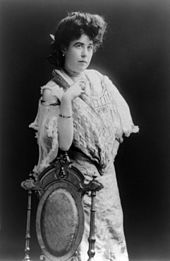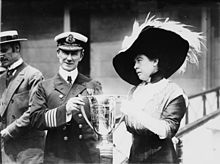Molly Brown
Margaret "Molly" Brown (born July 18, 1867 in Hannibal , Missouri , † October 26, 1932 in New York City ; nee Margaret Tobin ), also known as "The Unsinkable Molly Brown" ( The Unsinkable Molly Brown ), was one American women's rights activist who became famous as a survivor of the sinking of the Titanic .
Origin and family
As Margaret Tobin, she was born in 1867 as the second child to the Irish immigrants John Tobin (1820–1899) and Johanna Collins (1825–1905). She had three siblings: Daniel (* 1863), William (* 1869) and Helen (* 1871). There were also half-sisters Catherine Bridget Tobin from John Tobin's first marriage to Catherine Pickeral and Mary Ann Collins from their mother's first marriage. Both parents were widowed young.
Margaret grew up in one of the poorer areas of Hannibal and worked as a teenager in a tobacco factory. At the age of 18, Maggie, as she was known until their wedding, went to Leadville , Colorado with her half-sister Mary , where Mary and her husband John Landrigan opened a blacksmith shop. Margaret started working for the Daniels and Fisher Mercantile department store , sewing fabrics and carpets.
Marriage, boom, and social life
In the spring of 1886 she met the miner James Joseph Brown (born September 27, 1854, † September 5, 1922), the son of James Brown and Cecilia Palmer, who, like them, was descended from Irish immigrants. The couple married on September 1 of that year at the Annunciation Church in Leadville, Colorado. They lived on the 1340 Pennsylvania Avenue estate and had two children together:
-
Lawrence Palmer Brown , called Larry (August 30, 1887 - April 2, 1949)
- ∞ Eileen Elizabeth Horton (1890–1985) on January 1, 1911 in Kansas City, Missouri
Children: Lawrence Palmer “Pat” Brown, Jr. (1911–1976) and Eileen Elizabeth “Betty” Brown (1913–1974) - ∞ Mildred Lehman Gregory (1895–1956) on November 17, 1926 in Beverly Hills, California.
This marriage remained childless
- ∞ Eileen Elizabeth Horton (1890–1985) on January 1, 1911 in Kansas City, Missouri
-
Catherine Ellen Brown , called Helen (born July 1, 1889, † 1969)
- ∞ George Joseph Peter Adelheid Benziger (1877–1946) on April 7, 1913 in Chicago, Illinois
Children: James George Benziger (1914–1995) and George Peter Adelrich Benziger (1917–1985)
- ∞ George Joseph Peter Adelheid Benziger (1877–1946) on April 7, 1913 in Chicago, Illinois
Brown was very committed to society and, for example, helped out in the soup kitchen of the Leadville miners. In the early 1890s, her husband became the senior director of the Ibex Mines. In 1893, when Leadville unemployment was 90 percent, James Brown began mining gold at the Little Jonny Mine and became one of the wealthiest men in the state. Margaret Brown developed a taste for exclusive social occasions and expensive wardrobes. Some local newspaper articles reported extensively on costumes that Mrs. Brown wore to an event or an opera performance.
In April 1894, the Brown family moved to Denver, Colorado . It was here that Brown joined the Denver Woman's Club , an organization dedicated to the advancement, education, and equality of women. She became a staunch suffragette , campaigned for human rights and set up a fund to build hospitals, churches and schools. Through her work, she got to know many influential personalities such as Colonel John Jacob Astor , who supported her commitment and promoted her financially.
To curb widespread juvenile delinquency in deprived areas, Brown helped found the state's first juvenile justice system, which became the basis of today's American juvenile justice system. To educate herself, she attended the Carnegie Institute in New York , where she studied language and acting.
Molly Brown was one of the first women in the United States to run for public office. In July 1914, at a time when women did not yet have the right to vote, she and Alva Vanderbilt Belmont organized an international conference on women's rights in Newport , Rhode Island , which was attended by numerous women's and human rights activists.
In addition to her two own children, Molly Brown also raised her brother Daniel's three children: Grace, Florence and Helen. Daniel's wife died young. In 1909, Molly and James separated by mutual consent, but without filing for divorce. The reason for the separation were irreconcilable differences in conception and conduct of life, the spouses were too different.
On the Titanic
After separating from her husband, the American went on extensive trips. In the spring of 1912, she traveled with her daughter Europe , then joined in Cairo , Egypt , John Jacob Astor IV and his young wife Madeleine , which were on an extended honeymoon. At that time, she received a telegram from the States informing her that her grandson Lawrence Jr. was ill. Brown booked a first-class voyage on the next steamer to sail for America , the RMS Titanic . The Astors went with her on the evening of April 10 in the northern French port city of Cherbourg on board the luxury liner. Helen Brown, who actually wanted to go on the trip, decided at the last minute to stay in London .
When the Titanic collided with an iceberg at 11:40 p.m. on April 14, Brown urged many of the younger, strolling ladies to hurry. It was only more than an hour after the disaster that she could be persuaded to board the port lifeboat No. 6, which left the sinking ocean liner at 0.55 a.m. with 23 people on board. In this boat, with the exception of two male crew members (including the lookout Frederick Fleet , who had discovered the iceberg first and reported it to the bridge), all women from the first class were sitting . These included prominent upper-class women such as Elizabeth Rothschild, the writer Helen Candee , the women's rights activist Elsie Bowerman , the daughter of Fifth Avenue founder Andrew Saks , Leila Meyer and Sigrid Lindström, niece of the former Swedish Prime Minister Arvid Posse . Molly Brown, like many other women, took the helm. Stories that say she was in command of the lifeboat or even wielded it with a revolver in hand are not true, but found their way into many books and films about the Titanic disaster. In fact, boat no. 6 was steered by Quartermaster Robert Hichens , who was at the wheel of the Titanic at the time of the collision .
When after the ship's sinking at 2:20 a.m., the screams of the passengers fighting for their lives in the water echoed over to the occupants of the half-empty boat No. 6, Brown advocated rowing back to the scene of the accident immediately and picking up survivors. Because of the fear that the boat could overturn due to the onslaught of drowning people, she was unable to prevail. When boat no. 6 was picked up by the British passenger steamer RMS Carpathia , it was already light and most of the women were hypothermic.
Next life
In May 1912 Molly Brown presented the captain of the Carpathia , Arthur Rostron , a silver cup as a sign of recognition. She also gave each crew member a medal of honor. She later erected a Titanic memorial in Washington, DC that still exists today.
During the First World War , Brown was an active supporter of war victims - civil and military - and joined the American Committee for a Destroyed France , which cared for wounded soldiers and took care of the restoration of devastated towns in the front line.
In later years she rediscovered her passion for acting and went to Paris to study drama. She performed as a stage actress in Paris and New York.
Margaret Brown died of a brain tumor on October 26, 1932 at the Barbizon Hotel in New York at the age of 65 .
Others
- A museum in Denver called the Molly Brown House is dedicated to her.
- Avoca Lodge, known as Molly Brown Summer Home, in southwest Denver was used as a summer home by Brown and her husband. Tourists can both rent and tour it.
- The 1960s Broadway musical The Unsinkable Molly Brown and its 1964 film adaptation (German title: Goldgräber-Molly ) with Debbie Reynolds are based on her life story.
- 1965: Molly Brown was the name that astronaut Virgil Grissom gave the Gemini 3 spacecraft - an ironic allusion to the fact that during Grissom's first space flight with Mercury Redstone 4, the landing capsule sank in the Atlantic Ocean .
- In the later film adaptations of the ship's sinking, Molly Brown was portrayed by Tucker McGuire ( The Last Night of the Titanic , 1958), Cloris Leachman ( SOS Titanic , 1979), Marilu Henner ( Titanic , two-part TV series 1996) and Kathy Bates ( Titanic , 1997) .
literature
- Kristen Iversen (with a foreword by Muffet Brown): Molly Brown: Unraveling the myth. Johnson Books, Boulder 1999 - ISBN 1-55566-237-4
Web links
- Molly Brown in the Encyclopedia Titanica
- The Unsinkable Molly Brown on the Internet Broadway Database (1960 musical)
- The Unsinkable Molly Brown in the Internet Movie Database (1964 feature film)
- The Molly Brown House Museum (English)
Individual evidence
- ^ Titanic Memorial (Washington, DC). July 26, 2020, accessed on July 26, 2020 .
- ^ Molly Brown House. July 26, 2020, accessed July 26, 2020 .
- ↑ Avoca Lodge. July 27, 2020, accessed on July 27, 2020 .
| personal data | |
|---|---|
| SURNAME | Brown, Molly |
| ALTERNATIVE NAMES | Tobin Brown, Margaret |
| BRIEF DESCRIPTION | American philanthropist, women's rights activist, and Titanic survivor |
| DATE OF BIRTH | July 18, 1867 |
| PLACE OF BIRTH | Hannibal , Missouri |
| DATE OF DEATH | October 26, 1932 |
| Place of death | New York City |


